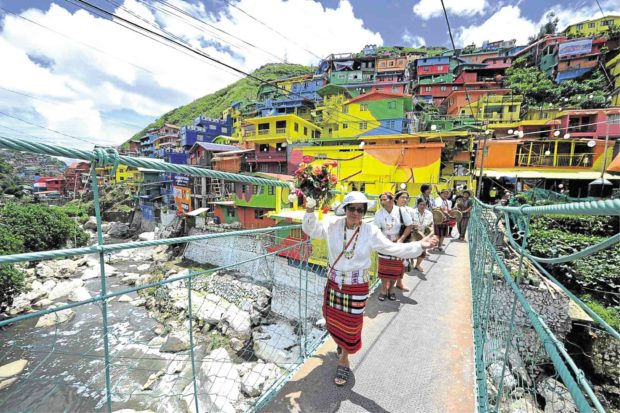Baguio rivers remain heavily polluted–DENR

DIRTY WATER, COLORFUL HOMES The Balili River flows through a hillside community in La Trinidad, Benguet province, that has become an attraction due to its brightly colored houses likened to Brazil’s favela (shantytown). Water quality in the river, however, has deteriorated as houses and business establishments sprout along Balili’s banks. —EV ESPIRITU
BAGUIO CITY — Two main rivers in the summer capital remain heavily polluted due in part to unregulated hog raising operations and sludge coming from Baguio’s public market and slaughterhouse, the Department of Environment and Natural Resources (DENR) said.
“Trillions of fecal coliform are being discharged into the Balili and Bued rivers,” Maria Victoria Abrera, Cordillera director of the Environmental Management Bureau, told reporters here on Wednesday.
Balili, the subject of rehabilitation programs by both the government and a consortium of Baguio and Benguet universities, flows down to La Trinidad, the Benguet provincial capital, and joins Tuel River in Sablan town.
Baguio shares Bued with the Benguet towns of Tuba and Itogon, which host some of the country’s oldest mines.
Backyard piggeries
Article continues after this advertisementAbrera said high concentrations of fecal matter had been detected along sections of Balili River that flow from the New Lucban area near the market and slaughterhouse, Teachers’ Camp and Barangay Gibraltar near the DENR Cordillera office compound.
Article continues after this advertisementBalili also has large volumes of phosphate and ammonia, which suggest that laundry and fertilizers from backyard gardens have been poisoning the waterway, she said.
Compared to Balili, Bued River’s pollution is slightly lower, Abrera said, adding that the highest fecal concentration is found in the waterway along Kennon Road, where more than 1,000 piggeries operate.
A creek connecting to Bued above the famous Lion’s Head landmark along Kennon Road is also polluted due to pocket mining and quarrying activities there.
The city government has been demolishing illegal backyard piggeries since 2018, as part of a 10-year plan to restore Balili and Bued rivers, outgoing Mayor Mauricio Domogan said.
The same plan focuses on an information drive to discourage households living near Balili River from dumping garbage into the water.
Underutilized
More than 50 percent of Baguio’s population (or 175,160 people) live in 74 villages where Balili flows before it enters La Trinidad, according to experts from the University of the Philippines Baguio, University of the Cordilleras, Saint Louis University and Benguet State University. These schools formed a consortium in 2011 to undertake the river’s rehabilitation.
A Baguio sewage treatment plant was built in 1986 using a Japanese grant to clean water being discharged into Balili.
But the Japan International Cooperation Agency concluded that the plant was underutilized and had not stemmed river pollution, following a 1991 study to improve the facility after the 1990 earthquake devastated the city. —VINCENT CABREZA